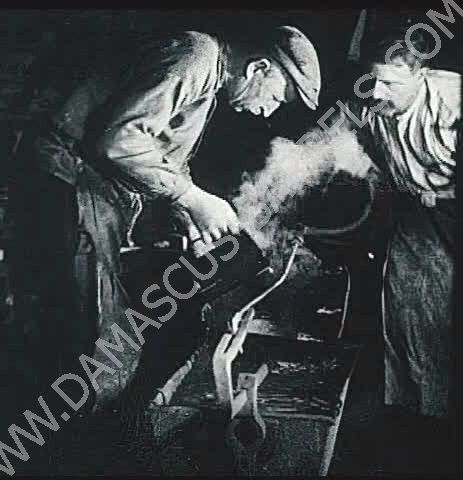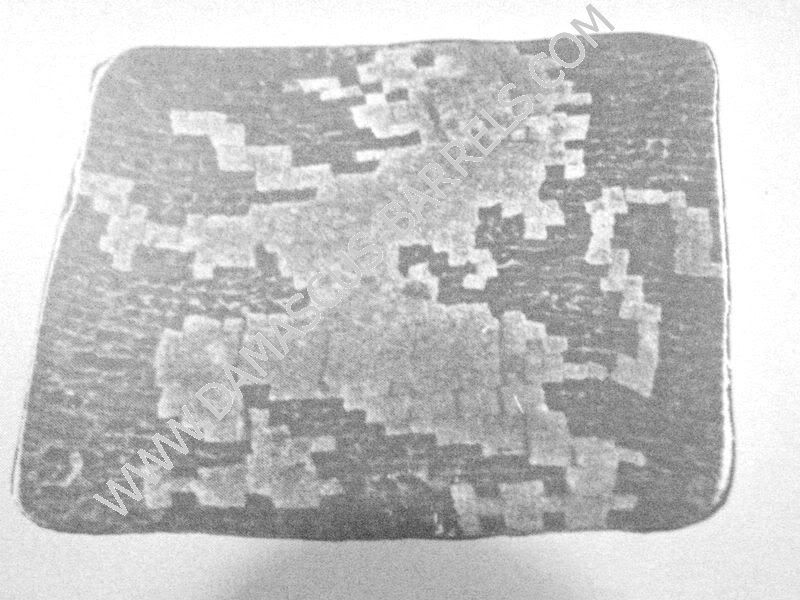|
S |
M |
T |
W |
T |
F |
S |
|
|
1
|
2
|
3
|
4
|
5
|
6
|
|
7
|
8
|
9
|
10
|
11
|
12
|
13
|
|
14
|
15
|
16
|
17
|
18
|
19
|
20
|
|
21
|
22
|
23
|
24
|
25
|
26
|
27
|
|
28
|
29
|
30
|
31
|
|
|
|
|
|
0 members (),
906
guests, and
5
robots. |
|
Key:
Admin,
Global Mod,
Mod
|
|
|
Forums10
Topics39,709
Posts564,482
Members14,611
| |
Most Online9,918
Jul 28th, 2025
|
|
|
|
Joined: Aug 2007
Posts: 12,202 Likes: 442
Sidelock
|

Sidelock
Joined: Aug 2007
Posts: 12,202 Likes: 442 |
Culver:
I have a question for you: how many rifled pattern welded tubes have you held? And a follow up being how many tubes have you made that were destined to be rifled?
Kind Regards,
Raimey
rse
|
|
|
|
|
Joined: Sep 2012
Posts: 129
Sidelock
|

Sidelock
Joined: Sep 2012
Posts: 129 |
I've not held a rifled, pattern welded barrel.
The tube that I am at this time installing on a project, was intended to be rifled. I have not yet rifled it, as I am uncertain whether a future buyer of the piece will wish for it to be rifled. I can certainly pull the barrel off and rifle it at a later date.
Regards,
|
|
|
|
|
Joined: Sep 2012
Posts: 129
Sidelock
|

Sidelock
Joined: Sep 2012
Posts: 129 |
The image below offers a fair representation of the progression of pattern development that happens as a bar of twisted laminate is ground towards the center of the bar. Honestly, I have never seen anything like drawing K. The illustration in drawing J is more representative of what will be found at the exact center of the bar. As you can see, a significant amount of material must be removed before the "stars" begin to form. In my experience, approximately 1/3 of the material must be ground away before the pattern starts to display the typical crolle form. 
|
|
|
|
|
Joined: Jan 2006
Posts: 9,819 Likes: 490
Sidelock
|
OP

Sidelock
Joined: Jan 2006
Posts: 9,819 Likes: 490 |
Thank you Steve! "It is the terminology used to describe the separate segments of the damascus pattern; "leaves" ( alternees), "scrolls", "1/2 scrolls". These terms are totally foreign to modern damascus makers. If I understand correctly, these terms were coined by Dr. Gaddy?" That is correct, but I'm not able to provide a specific reference. And for your interest; Indo-Persian "Twisted Stars" pattern  A Turkish percussion pistol barrel 
Last edited by Drew Hause; 01/17/13 09:28 PM.
|
|
|
|
|
Joined: Jan 2006
Posts: 9,819 Likes: 490
Sidelock
|
OP

Sidelock
Joined: Jan 2006
Posts: 9,819 Likes: 490 |
You've no doubt seen this; the 'Lopin' (billet of iron and steel bars) prior to rolling Top: Etoile'/Star Left: Double 81 Bernard Middle: Extra-Fine Crolle Right: Washington  Etoile' I believe in Sachse 
Last edited by Drew Hause; 01/17/13 09:35 PM.
|
|
|
|
|
Joined: Feb 2009
Posts: 7,714 Likes: 347
Sidelock
|

Sidelock
Joined: Feb 2009
Posts: 7,714 Likes: 347 |
Thanks for the pictures folks.
Just guessing, but if there's a dark layer in the center of the stack, is 'K' possible. I'd also think 'J' would have at least a little tilt to the stars to at least follow the pitch of the twist. Maybe not though, interesting to reverse engineer, or try to, the great patterns that can show up.
I like to watch if a barrel maker was able to maintain their pattern through the entire barrel. The good makers must have known their stuff, not to change the pattern through uneven grinding as the barrel tapered breech to muzzle.
|
|
|
|
|
Joined: Nov 2005
Posts: 4,598
Sidelock
|

Sidelock
Joined: Nov 2005
Posts: 4,598 |
The 1st step is controlling the rate of twist. To the best of my knowledge this was never written down, but passed from master to apprentice.  They were able to form any image they choose. This is just one cross section from a series that are on display in Liege,  Pete
|
|
|
|
|
Joined: Nov 2012
Posts: 57
Sidelock
|

Sidelock
Joined: Nov 2012
Posts: 57 |
I've seen damascus barrels with the name of the gunmaker incorporated in the pattern. How did they do that, given that you need to remove one third of the material before the pattern begins to show? Another lost art?
|
|
|
|
|
Joined: Sep 2012
Posts: 129
Sidelock
|

Sidelock
Joined: Sep 2012
Posts: 129 |
I will begin with an explanation of damascus steel and the methods used to create it. Once I have established the basic understanding of what damascus steel is and how it is made, I will circle back to answer your specific questions about it. Be patient; this could become a very long thread.
The making of pattern welded damascus, is the purposeful manipulation of layers of chemically different materials to create a pattern in the surface of a finished product. The patterns are made by manipulating edges of the layers to the surface of the finished piece where they will form a predefined pattern. As the elements are chemically different, they will be differentially affected by etchant and/or patina solutions to make the pattern visible.
The very simplest of damascus begins as a stack of flat materials. Typically, of alternating layers of two chemically different types of steel, or of steel and iron. The stack is forge welded into a solid mass, producing what today in the US, is commonly called a billet. Older terms were faggot and lopin, and I'm sure other names in different parts of the world. This billet is then drawn out by forging, pressing and/or rolling, into bar stock.
It is entirely possible, by very controlled dimensional reduction to maintain the layers in their original flat arraignment. The resulting pattern will be of simple straight lines. As there is little aesthetic appeal in a straight line pattern, the material is typically manipulated to displace the layers relative to their original positions in the billet. This is often done by mechanical manipulation, or a combination of stock removal plus mechanical manipulation. In the damascus pattern that we today call "random pattern", the mechanical manipulation is simply from the impact of the hammer on the layers of material. Each hammer blow displaces the layers and results in a circular pool shape in the surface of the finished piece. Overlapping hammer blows create overlapping pool shapes, the final appearance having what many call a wood-grain effect.
More purposeful manipulation of the layers can be accomplished by twisting, forging at an angle to the arrangement of the layers, stock removal by cutting through the layers and then forging the stock flat to raise the cut-through layers to the surface, or by pressing the layers with pattern dies to raise layers into the die pattern and then grinding of the raised areas to expose the upward turned edges of the layers. The billet can also be cut into angular sections, that are then restacked to organize the layers of material into a specific pattern. The restacked segments are then forge welded into a solid billet. The patterns possible are absolutely endless. Many modern damascus smiths who specialize in very complicated patterns, use "Play-Doh" to plan for the creation of damascus patterns. Using different colors of "Play-Doh" they can formulate a manipulation process to create specific patterns in steel.
Another form of damascus pattern creation is what we today call mosaic damascus. In mosaic damascus, elements are stacked in an arrangement to create words or pictures. The picture that Pete posted of the rampant lion, is an excellent example of early mosaic damascus (thanks Pete!!). The lion was created by stacking small square rods of material together, then surrounding them with rods of a different material. This stack then being forge welded into a solid mass. To make assembly and welding easier, these arrangements of materials to create pictures and words are typically much larger than will be desired in the finished product. Once welded together, the stock will be dimensionally reduced as evenly as possible, so as not to introduce distortion in the design. After a degree of size reduction, the design is often stacked into another assembly of elements, to again be forge welded into a solid mass for additional reduction to a dimension suitable for use in the finished product. In this way, a picture, such as the rampant lion may be assembled with an original dimension of perhaps 3 inches tall. It can then be dimensionally reduced to the size of a pin head for use in the finished product.
Early mosaic damascus was typically assembled from square rods , or other dimensional stock; as seen in the rampant lion photo. Modern mosaic damascus is often made by using water jet or EDM machines to cut out the shapes. Nickel is often used for the primary shape in modern mosaic damascus, as it resists the etchant solution and will display prominently when surrounded by high carbon steel. The primary design shape can be placed into a perfectly fitted hole, cut into a section of high carbon steel by the same water jet or EDM process. This assembly is then forge welded together. Or, the primary shape can be placed into a steel container, such as a piece of pipe, then powdered steel is poured around the primary to fill the container. The container is then sealed and forge welded into a solid mass.
To be continued…………
|
|
|
|
|
Joined: Nov 2012
Posts: 57
Sidelock
|

Sidelock
Joined: Nov 2012
Posts: 57 |
WOW.Where else can you get this great info? I want more damascus guns and knives just to be around this interesting technology.
|
|
|
|
|